Key takeaways
- Activist teacher resources encourage deeper engagement and empathy, transforming education into a tool for inspiring active citizenship.
- Simulations in history teaching foster curiosity and critical thinking by allowing students to explore complex topics in an immersive, relatable manner.
- Effective simulations require careful design, including clear roles, emotional stakes, and thoughtful debriefing to enhance student reflection and learning.
- Preparation, pacing, and a compassionate classroom environment are essential for maximizing the impact of simulation experiences on student understanding.

Understanding activist teacher resources
When I first came across activist teacher resources, I was struck by how much they challenged traditional teaching methods. These materials are designed not just to inform, but to inspire students to question, engage, and act. Have you ever felt that your lessons could do more than just deliver facts? That’s exactly what these resources invite us to explore.
One thing I’ve realized using these resources is that they bring a sense of urgency and relevance to the classroom. They don’t shy away from difficult topics or uncomfortable truths, which can sometimes make us uncomfortable but ultimately leads to deeper understanding. It’s like suddenly seeing history not as a distant story, but as a living force shaping our world and our choices.
The beauty of activist teacher resources lies in their ability to connect education with empathy and action. They push us to think beyond exams and grades, focusing instead on nurturing active, thoughtful citizens. I often find myself reflecting on how this approach transforms both teaching and learning into something truly meaningful.
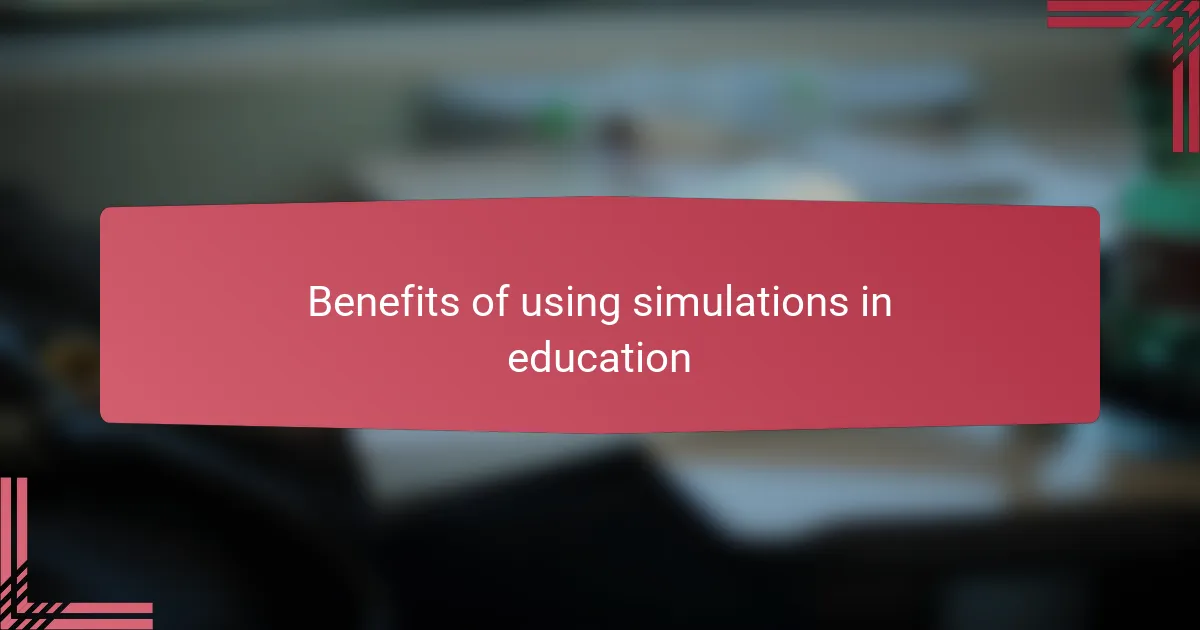
Benefits of using simulations in education
Using simulations in education has been a game-changer for me because they bring history to life in a way textbooks simply can’t. When students step into the shoes of historical figures or communities, I see their curiosity deepen and their empathy grow. Isn’t it powerful when learners stop memorizing dates and start feeling the weight of decisions made long ago?
I’ve noticed that simulations encourage active participation, making students collaborators rather than passive consumers of information. This engagement often sparks lively discussions and critical thinking—something I always hope for but don’t always get with traditional lectures. It’s rewarding to watch students connect the dots themselves, wrestling with complexities instead of accepting simplified narratives.
Another benefit that stands out is how simulations create a safe space for exploring difficult topics. When students enact different perspectives, they confront uncomfortable truths, but in a controlled environment where questions are encouraged. I find this deepens their understanding and challenges their preconceived notions in ways I hadn’t expected when I first started using simulations. Have you experienced that surprise moment when a student suddenly “gets it” because they lived it, even just pretend? That’s what makes the effort worthwhile.
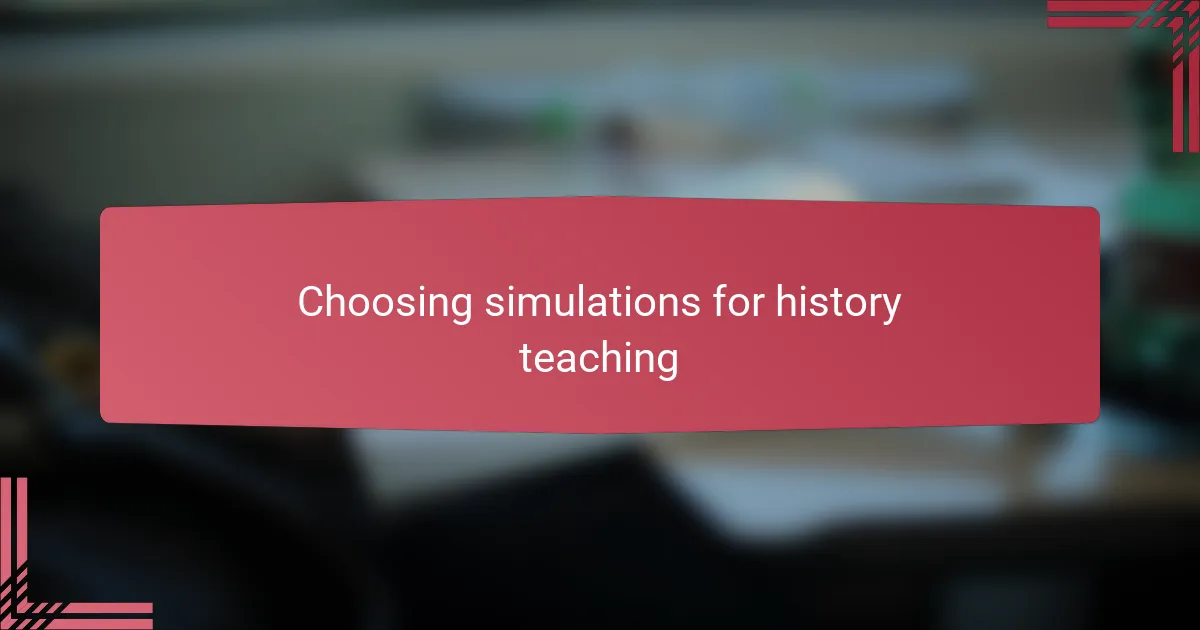
Choosing simulations for history teaching
Choosing the right simulation for history teaching isn’t just about picking something flashy or popular; it’s about finding one that resonates with your students and fits the lesson’s goals. I remember once selecting a simulation focused on the civil rights movement because it offered diverse perspectives and forced students to grapple with moral dilemmas—something that sparked genuine reflection and debate. Have you ever felt that a simulation either fell flat or truly opened a door in your students’ thinking? That contrast shaped how selective I’ve become over time.
Another thing I’ve learned is to consider the level of complexity and emotional impact a simulation brings. Some of my students can get overwhelmed if the scenario is too dense or the stakes feel too distant, so I’ve found it helpful to start with simulations that are relatable and gradually increase the challenge. When I chose a simulation on immigration struggles, the students connected personally through stories that echoed their own family histories, making the experience unforgettable. Isn’t it incredible how the right simulation can turn abstract history into something deeply personal?
Of course, aligning simulations with activist goals means prioritizing those that encourage critical questioning and empathy. I always ask myself: Does this simulation push learners to see structural issues and their role in change? If it doesn’t provoke that kind of thinking, then it’s just a game, not a teaching tool. Finding simulations that allow students to take on active roles—not just passive observers—has been key in making history feel alive and urgent in my classroom. What about you—how do you evaluate whether a simulation truly activates your students?
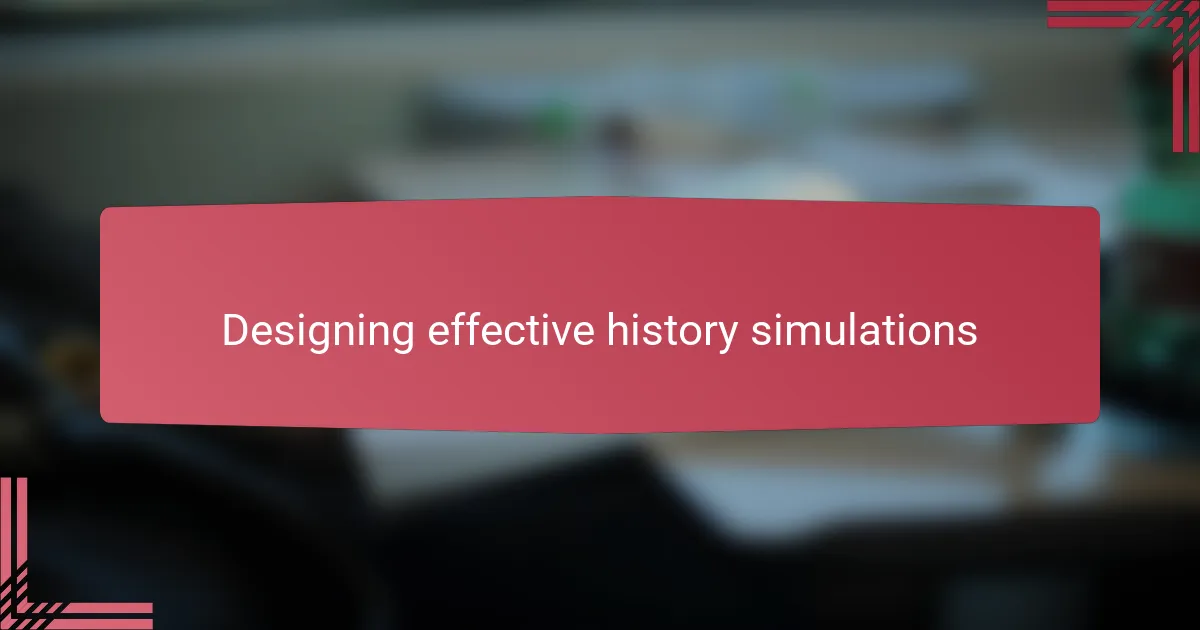
Designing effective history simulations
Designing effective history simulations starts with crafting scenarios that balance accuracy and accessibility. I’ve found that too much complexity can overwhelm students, while oversimplification risks losing the historical depth. How can you keep students engaged without sacrificing nuance? From my experience, tailoring simulations to fit your students’ backgrounds and readiness makes all the difference.
Another crucial aspect is embedding clear roles and stakes into the simulation. When students understand their characters’ motivations and face real consequences—albeit in a safe classroom setting—they invest emotionally and intellectually. I recall a simulation on the French Revolution where students debating confiscation of [censured] property became genuinely passionate, even conflicted. That level of engagement is what turns a good simulation into a memorable learning moment.
Finally, I believe thoughtful debriefing transforms simulation experiences from mere role-play into meaningful reflection. Prompting students to question their assumptions, connect past struggles to present issues, and consider their own agency helps cement the lessons. Have you noticed how a well-guided discussion after a simulation often sparks the deepest insights? That, to me, is the true power of designing simulations with intention.
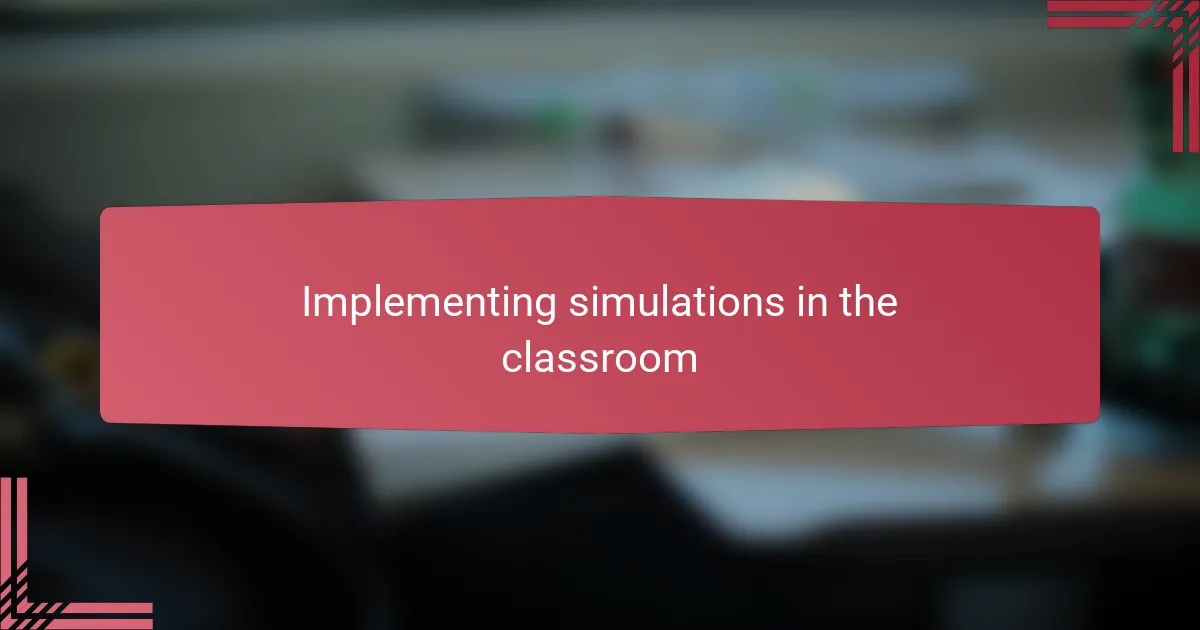
Implementing simulations in the classroom
Implementing simulations in the classroom requires careful preparation—I’ve learned that setting clear expectations and providing students with well-defined roles helps create an immersive experience. When I first tried this, I saw the difference it made: students were more focused and invested because they understood their part in the story unfolding.
Timing is another factor I’ve found essential. Starting with a brief introduction and allowing enough time for the simulation, followed by reflection, keeps the energy high. I remember one session where I rushed the debrief, and the rich conversations I hoped for didn’t happen—since then, I make sure to carve out space for thoughtful discussion.
Creating a supportive environment is crucial too. Sometimes emotions run high as students wrestle with difficult historical realities, so I encourage open dialogue and remind them that the classroom is a safe place to explore tough questions. It’s in those moments of vulnerability that real learning happens, and I’ve witnessed students grow profoundly through this process.
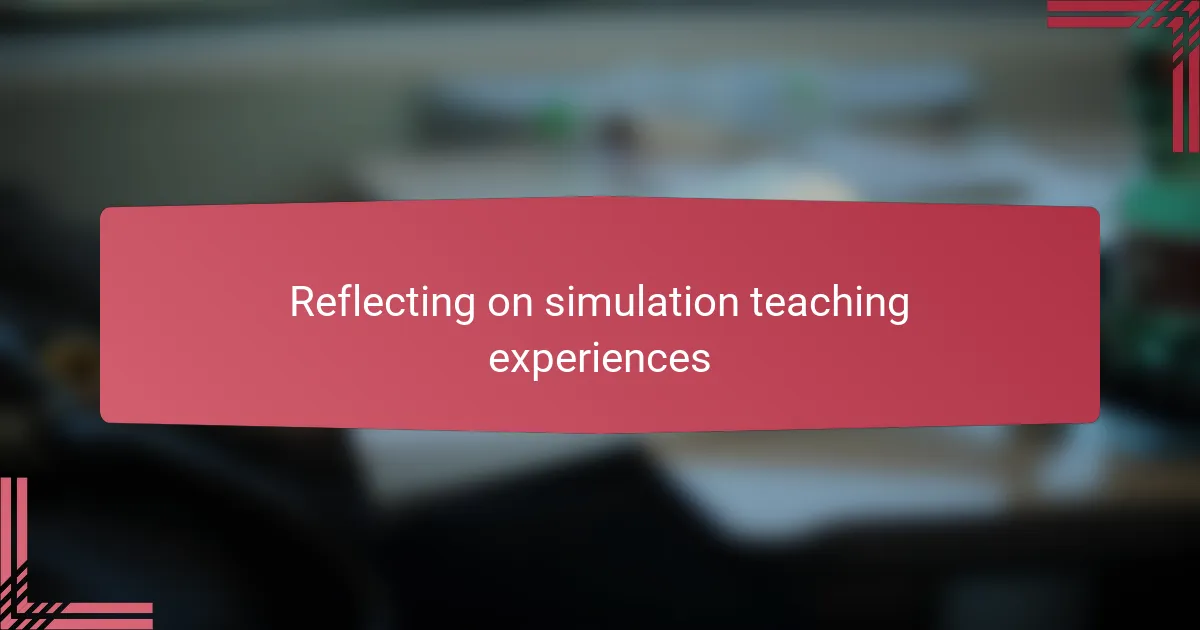
Reflecting on simulation teaching experiences
Reflecting on my simulation teaching experiences, I often find myself amazed at how these activities reveal students’ thinking in unexpected ways. Have you ever noticed how a student’s perspective can shift dramatically after embodying a historical figure, wrestling with the same dilemmas they faced? Those moments remind me that teaching history isn’t just about conveying facts—it’s about provoking empathy and insight.
Sometimes, I feel that the biggest learning happens during reflection, not the simulation itself. After one particularly intense role-play on colonialism, students shared feelings of frustration and confusion, which sparked honest conversations about power and resistance. Isn’t it remarkable how simulation experiences open space for emotional engagement that traditional lessons rarely achieve?
That said, I’ve also learned that not every simulation lands perfectly the first time. There have been occasions when I underestimated the complexity or emotional weight for my students. But each “misstep” offered valuable insights into pacing, preparation, and how to support learners through challenging content. Do you also find that reflecting on what didn’t work is just as important as celebrating what did? For me, those reflections continue to shape and deepen my practice.
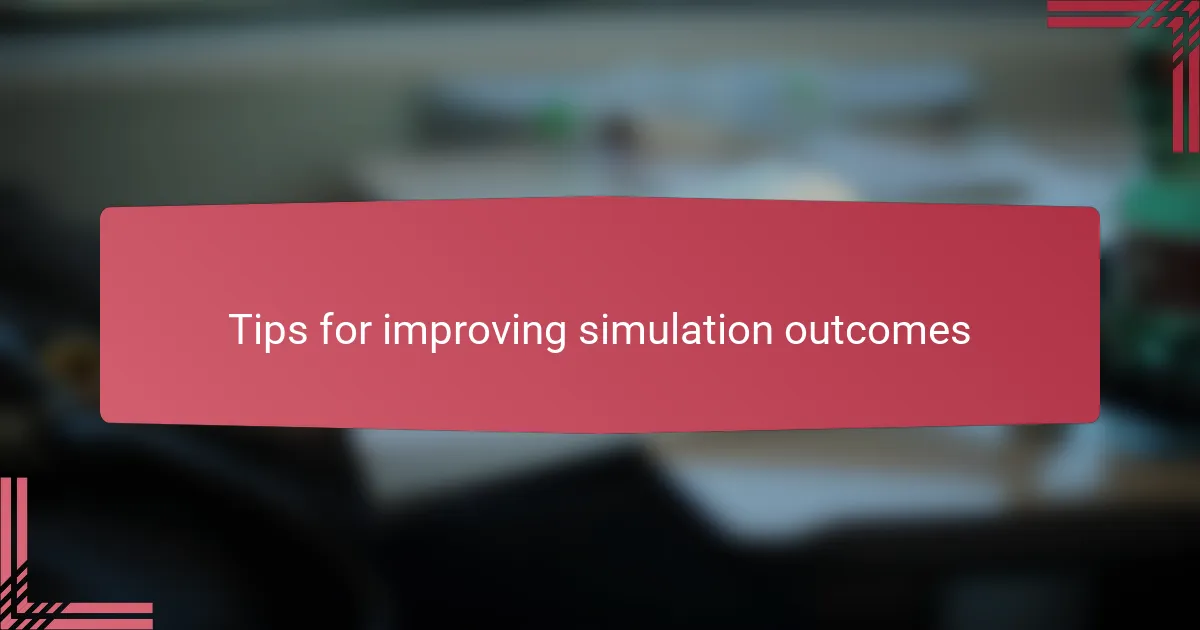
Tips for improving simulation outcomes
One tip I’ve found crucial is to prepare students thoroughly before jumping into the simulation. When I skipped this step early on, some students felt lost or overwhelmed. Now, I spend time clarifying roles and setting expectations, which makes their participation more confident and meaningful. Have you noticed how a little preparation can turn hesitation into active engagement?
Another strategy that’s helped me improve outcomes is pacing the simulation carefully. Early on, I underestimated how long deep discussions take, which cut short some rich moments. These days, I build in extra time for reflection and dialogue afterward, knowing that’s when real breakthroughs happen. Isn’t it amazing how pausing to unpack emotions and ideas often reveals the heart of the learning?
Finally, I’ve learned that fostering a compassionate classroom atmosphere is key. Simulations often bring up tough emotions as students wrestle with historical injustices or moral dilemmas. When I remind students that it’s safe to express confusion or frustration, I see them open up in ways that enrich everyone’s understanding. How often do we overlook the power of empathy in making simulations truly impactful? For me, it’s been a game-changer.